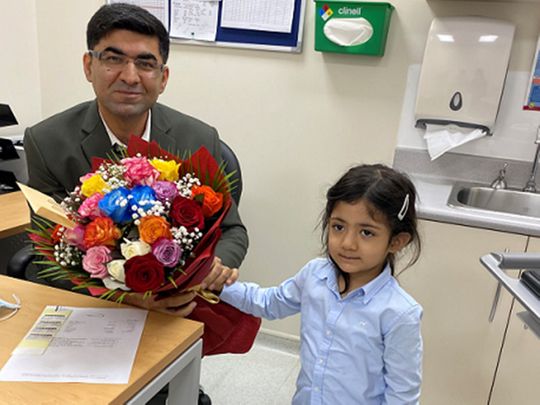
Sharjah: University Hospital Sharjah (UHS) successfully carried out a complex surgery for hydrocephalus, a condition that causes build-up of the Cerebro Spinal Fluid (CSF) in the cavities deep within the brain, for a four-year-old girl.
The girl had a history of Congenital Hydrocephalus and came in for consultation with UHS surgeons accompanied by her parents. She was not only suffering from hydrocephaly, but also had an insertion of a Ventriculoperitoneal shunt that was carried out when she was six months old, to drain the excessive fluid. The child was complaining of abdominal pain, intermittent vomiting, and abdominal distension for the previous two weeks prior to this consultation.
UHS staff reported that upon arrival, the patient was vitally stable, had no fever and was fully conscious with normal developmental milestones. The clinical evaluations revealed a properly positioned ventricular catheter, and a large abdominal pseudocyst.
Surgery brings relief
She underwent an ultrasound-guided drainage of abdominal pseudocyst collection. However, she further went on to develop massive abdominal distension associated with vomiting in a few days, and underwent laparoscopic fenestration of pseudocyst (fluid aspiration from the cyst) and repositioning of peritoneal catheter.
Furthermore, the first follow up visit revealed that the child continued to have a distended abdomen. An ultrasound confirmed the presence of massive fluid retention. The surgeon determined that the abdomen was not functioning or absorbing CSF effectively and instructed the implantation of a Programmable Ventriculoatrial shunt with the help of the anaesthesia team. The procedure was a success and her condition remained stable with a normal postoperative course.
Dr Ali Obaid Al Ali, UHS CEO and Member of the Board of Trustees, said: “We are proud to announce that UHS has successfully completed a complex procedure for Congenital Hydrocephalus, leveraging our state-of-the-art technology, experienced professional consultants, and advanced operation theatres. We hope to serve more patients from the UAE and GCC, where they can benefit from our comprehensive expertise and standardized high-quality services to live a healthy life.”
Common treatment
Many chidren are born with hydrocephaly. The most common treatment for Congenital Hydrocephalus is a shunt system, where a surgeon will place a flexible plastic tube in the infant’s brain to drain the extra fluid, with the other end of the tube going under the skin and into the belly, or another place in the body where the excess CSF can be absorbed.
In an identical case, a three-year-old male patient with a history of Congenital Hydrocephalus, who was also COVID-19 positive, underwent a VP shunt insertion at the age of six months at UHS. Similarly, a nine-month old male infant, who had been operated on more than six times in five months for Hydrocephalus and associated shunt infection, also underwent a shunt tapping procedure, under complete aseptic techniques, by the combined expertise of multiple pediatric surgeons at UHS.










